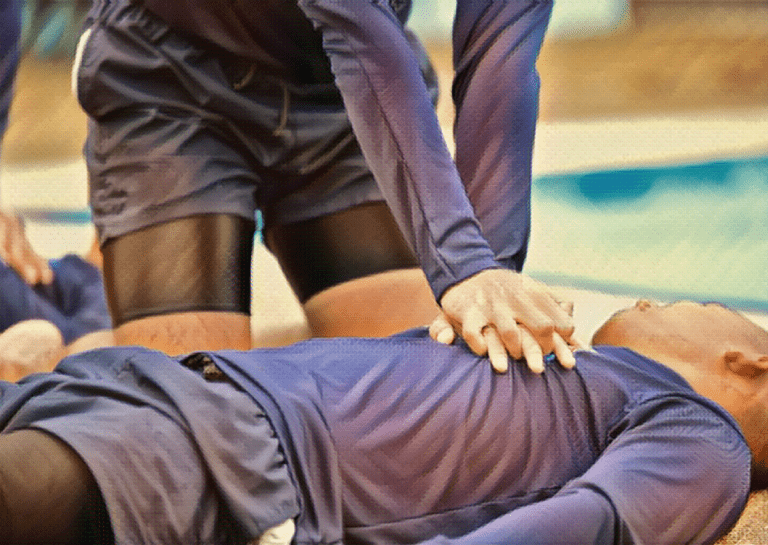Cardiopulmonary Resuscitation (CPR) is a life-saving technique performed in emergency situations involving cardiac arrest.
It often combines chest compressions with artificial ventilation and works by restarting the heart and restoring the circulation of blood and oxygen through the body. CPR should, if possible, be combined with defibrillation using an Automated External Defibrillator (AED). CPR is an emergency measure used to stabilize the patient until they can be fully treated by medical professionals.
Table of contents
Who can perform CPR?
Anyone can perform CPR to some extent in emergency situations, whether they have been trained or not. While not everyone will be trained in delivering rescue breathing (‘mouth-to-mouth’), chest compressions are the most crucial element of CPR and can be performed by lay bystanders.
The procedure for CPR depends on who is performing the technique — for example, a lay bystander or a trained paramedic. Many people who are untrained in CPR will understandably be afraid to intervene when someone’s heart stops beating. But anyone can perform chest compressions with or without formal training. Early intervention is absolutely essential to preventing brain damage, organ failure, and death.
The American Heart Association recommends that untrained bystanders perform hands-only CPR, which consists of hard and fast chest compressions without mouth-to-mouth rescue breathing. Hands-only CPR is often enough to get the blood pumping while help is on the way.
Trained bystanders who are confident in their abilities are advised to check the patient’s pulse and breathing and to deliver chest compressions with rescue breathing.
Guidelines for performing CPR are as follows.
What is ‘excellent CPR’?
The term ‘excellent’ used with regard to Basic Life Support (BLS) refers to the minimum level of adequate resuscitation in patients with cardiac arrest. Anything less than excellent CPR does not get the blood pumping efficiently enough to prevent neurological damage.
Recognizing cardiac symptoms
Early recognition of cardiac arrest can mean the difference between life and death. Restoring cardiac function and oxygen circulation as early as possible is key to survival and preventing brain damage [1]. Symptoms or precursors of cardiac arrest in others can include obvious signs such as fainting and loss of consciousness, or complaints of feeling unwell. Look out for the following signs:
- Loss of consciousness/sudden collapse
- Shortness of breath
- Dizziness
- Chest pains
- Seizures
- Nausea
When to use CPR
CPR should be used when a person has become unresponsive, and their heart has stopped beating properly. It is vital that CPR is started as soon as possible [2]. A person whose heart has stopped circulating oxygen can become brain-dead in less than 5 minutes. Early intervention greatly increases a patient’s chances of survival and recovery.
CPR guidelines
Performing chest compressions
- Ensure the patient is lying on a firm surface.
- The rescuer should be positioned with their own chest directly above their hands, enabling them to use their full body weight rather than their arm strength to perform adequate chest compressions.
- The rescuer should place the heel of one hand over the lower portion of the sternum in the middle of the chest and the other hand over the first.
- Chest compressions are often performed incorrectly or inconsistently due to excessive interruptions. It is important that there are no interruptions made when performing chest compressions, such as checking for a pulse.
- The depth and rate of chest compressions are important. Compressions should be at least 2 inches in depth but no more than 2.5 inches, and deep enough for full chest recoil (for the chest to return to its normal position). The rescuer should allow the chest to recoil after each compression while maintaining a consistent rate. Chest compressions should be performed 100 to 120 times per minute at a consistent rhythm.
- Performing chest compressions is laborious and rescuers can become fatigued after just 1 minute. For this reason, it is recommended that another rescuer take over at 2-minute intervals, at which point the cardiac rhythm should be reassessed.
Performing rescue breathing
- In the event of pulselessness, chest compressions should be prioritized over mouth-to-mouth resuscitation. However, it is important to incorporate rescue breathing when pulselessness persists and the body’s oxygen supplies have become depleted.
- The rescuer should give two ventilations after every 30 compressions.
- Each ventilation should take no more than one second.
- Avoid over-ventilation with excessive rate or volume. Each ventilation should be just enough to make the chest visibly rise.
- Deliver 8 to 10 breaths per minute, making sure to avoid excessive ventilation. Over-ventilation can reduce both the effectiveness of chest compressions and the patient’s chances of survival.
References
- Duval S, Pepe PE, Aufderheide TP, et al. Optimal Combination of Compression Rate and Depth During Cardiopulmonary Resuscitation for Functionally Favorable Survival. JAMA Cardiol 2019; 4:900.
- Kleinman ME, Brennan EE, Goldberger ZD, et al. Part 5: Adult Basic Life Support and Cardiopulmonary Resuscitation Quality: 2015 American Heart Association Guidelines Update for Cardiopulmonary Resuscitation and Emergency Cardiovascular Care. Circulation 2015; 132:S414.
- Merchant RM, Topjian AA, Panchal AR, et al. Part 1: Executive Summary: 2020 American Heart Association Guidelines for Cardiopulmonary Resuscitation and Emergency Cardiovascular Care. Circulation 2020; 142:S337.
